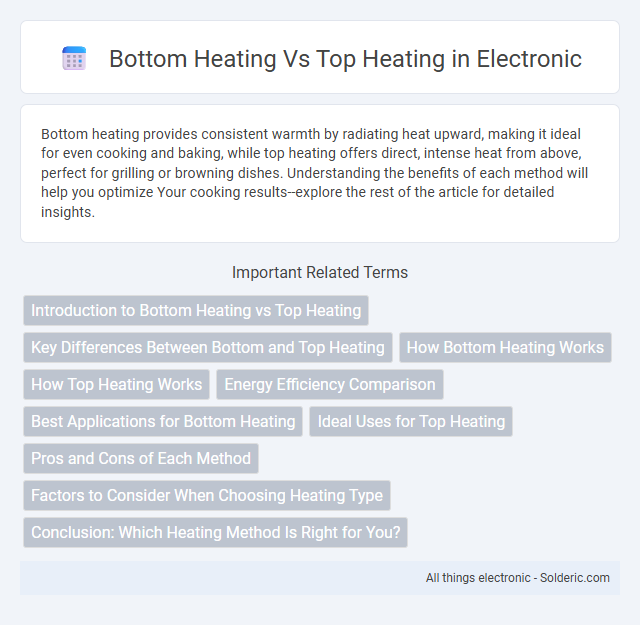Bottom heating provides consistent warmth by radiating heat upward, making it ideal for even cooking and baking, while top heating offers direct, intense heat from above, perfect for grilling or browning dishes. Understanding the benefits of each method will help you optimize Your cooking results--explore the rest of the article for detailed insights.
Comparison Table
| Feature | Bottom Heating | Top Heating |
|---|---|---|
| Heat Source Position | Underneath the cooking surface | Above the cooking surface |
| Primary Use | Baking, slow cooking, even heat distribution | Grilling, browning, broiling, finishing dishes |
| Heat Intensity | Moderate, consistent heat | High, direct heat |
| Common Appliances | Ovens, pizza ovens, electric cooktops | Broilers, salamanders, grilling elements |
| Cooking Effects | Even cooking, prevents burning from above | Crisping, browning, caramelizing surfaces |
| Energy Efficiency | Generally more energy-efficient for long cooking | Consumes more power for quick heating |
| Best For | Bread, casseroles, pizza bases | Steaks, gratins, toasting |
Introduction to Bottom Heating vs Top Heating
Bottom heating delivers warmth directly from the floor, ensuring even heat distribution and enhanced comfort, especially in colder climates. Top heating, commonly provided by overhead radiators or ceiling panels, tends to create warmer air near the ceiling, which can lead to uneven room temperatures and energy inefficiency. Understanding the differences between bottom and top heating systems helps you optimize your home's heating strategy for energy savings and comfort.
Key Differences Between Bottom and Top Heating
Bottom heating provides consistent warmth by radiating heat upwards from beneath, making it ideal for baking and cooking that requires even heat distribution on the base. Top heating delivers direct heat from above, perfect for browning, grilling, or finishing dishes with a crispy surface. Understanding these key differences helps you optimize cooking results based on the specific heating method your appliance offers.
How Bottom Heating Works
Bottom heating works by distributing warmth evenly across the lower part of an appliance or surface, such as in ovens or heated floors, allowing heat to rise naturally and cook or warm items from the base upwards. This method promotes consistent temperature control and prevents burning or overcooking on the top while ensuring thorough heating at the bottom. In comparison to top heating, bottom heating emphasizes gradual and uniform heat transfer, ideal for baking, drying, and maintaining warmth.
How Top Heating Works
Top heating works by distributing warm air from above, allowing heat to radiate downward evenly across the space, which enhances comfort and efficiency in temperature regulation. This method leverages convection currents, where hot air rises and cool air descends, promoting better circulation and minimizing cold spots. Your environment benefits from consistent warmth and quicker heating times compared to bottom heating systems.
Energy Efficiency Comparison
Bottom heating systems typically offer better energy efficiency by providing consistent heat distribution from the floor up, reducing heat loss and maintaining comfortable temperatures at lower thermostat settings. Top heating methods often result in heat rising quickly and accumulating near the ceiling, causing uneven warmth and increased energy consumption to maintain desired comfort levels. Studies show that bottom heating can reduce energy usage by up to 20% compared to top heating, making it a more sustainable choice for long-term energy savings.
Best Applications for Bottom Heating
Bottom heating is ideal for applications requiring uniform heat distribution and consistent moisture retention, such as baking bread or pizzas where a crisp crust is desired. It effectively promotes even rising and browning due to direct heat exposure on the base, making it perfect for pastries, pies, and casseroles. This method also enhances heat control for delicate dishes that benefit from gentle, steady warmth from below.
Ideal Uses for Top Heating
Top heating is ideal for applications requiring intense, direct heat such as broiling, grilling, or finishing dishes with a crispy crust. It works best for melting cheese, browning toppings, or quickly caramelizing surfaces without overcooking the interior. You can achieve optimal results in recipes that benefit from focused radiant heat applied from above.
Pros and Cons of Each Method
Bottom heating ensures even warmth distribution and prevents food from burning, making it ideal for baking delicate pastries, but it might result in less browning on the top. Top heating promotes browning and crisping, perfect for gratins or broiling, yet it can cause uneven cooking or drying out if used alone. Your choice depends on the dish's requirements, balancing consistent heat from bottom elements with the browning effect of top heaters.
Factors to Consider When Choosing Heating Type
Choosing between bottom heating and top heating depends on factors such as heat distribution efficiency, energy consumption, and the specific application or environment. Bottom heating often provides more uniform warmth and is ideal for applications like underfloor heating or seed germination, while top heating may be better suited for targeted warmth and quick temperature changes. Consider the material to be heated, desired temperature control, installation complexity, and energy costs to select the most effective heating type.
Conclusion: Which Heating Method Is Right for You?
Bottom heating offers consistent, even warmth ideal for delicate plants and seedlings, while top heating provides quicker surface warmth suited for mature plants requiring intense heat. Consider plant type, growth stage, and desired temperature control when choosing between these methods. Selecting the right heating approach enhances plant health, growth rate, and overall cultivation success.
Bottom heating vs top heating Infographic

 solderic.com
solderic.com